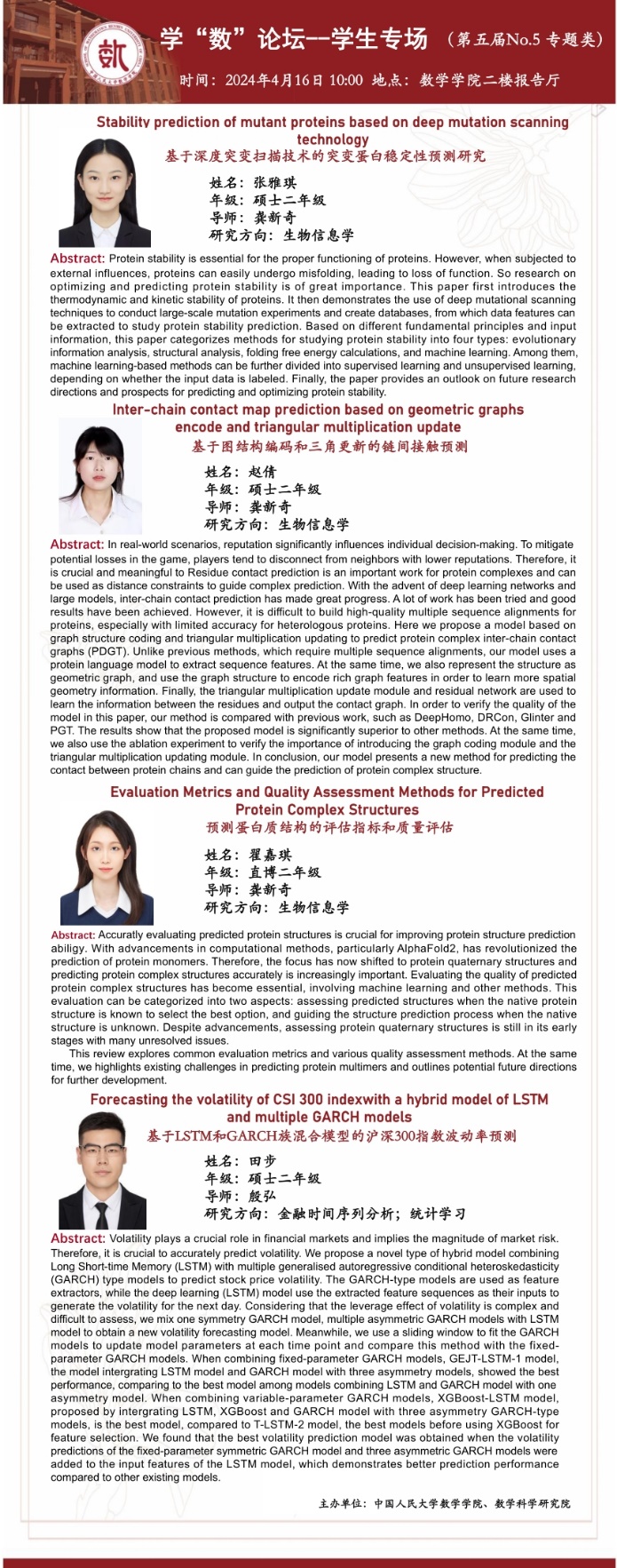第五届学“数”论坛——学生专场第五期(学术类)预告
大家好,本届学“数”论坛——学生专场的第二场报告来啦!本场报告类型为学术类,将于2024年4月16日10:00在数学学院二楼报告厅举办。主讲嘉宾为硕士二年级张雅琪同学、硕士二年级赵倩同学、直博二年级翟嘉琪同学、硕士二年级田步同学。
张雅琪同学师从我院龚新奇老师,主要研究方向是生物信息学。本次报告题目为《基于深度突变扫描技术的突变蛋白稳定性预测研究》,报告内容主要如下:
Protein stability is essential for the proper functioning of proteins. However, when subjected to external influences, proteins can easily undergo misfolding, leading to loss of function. So research on optimizing and predicting protein stability is of great importance. This paper first introduces the thermodynamic and kinetic stability of proteins. It then demonstrates the use of deep mutational scanning techniques to conduct large-scale mutation experiments and create databases, from which data features can be extracted to study protein stability prediction. Based on different fundamental principles and input information, this paper categorizes methods for studying protein stability into four types: evolutionary information analysis, structural analysis, folding free energy calculations, and machine learning. Among them, machine learning-based methods can be further divided into supervised learning and unsupervised learning, depending on whether the input data is labeled. Finally, the paper provides an outlook on future research directions and prospects for predicting and optimizing protein stability.
赵倩同学师从我院龚新奇老师,主要研究方向是生物信息学。本次报告题目为《基于图结构编码和三角更新的链间接触预测》,报告内容主要如下:
Residue contact prediction is an important work for protein complexes and can be used as distance constraints to guide complex prediction. With the advent of deep learning networks and large models, inter-chain contact prediction has made great progress. A lot of work has been tried and good results have been achieved. However, it is difficult to build high-quality multiple sequence alignments for proteins, especially with limited accuracy for heterologous proteins. Here we propose a model based on graph structure coding and triangular multiplication updating to predict protein complex inter-chain contact graphs (PDGT). Unlike previous methods, which require multiple sequence alignments, our model uses a protein language model to extract sequence features. At the same time, we also represent the structure as geometric graph, and use the graph structure to encode rich graph features in order to learn more spatial geometry information. Finally, the triangular multiplication update module and residual network are used to learn the information between the residues and output the contact graph. In order to verify the quality of the model in this paper, our method is compared with previous work, such as DeepHomo, DRCon, Glinter and PGT. The results show that the proposed model is significantly superior to other methods. At the same time, we also use the ablation experiment to verify the importance of introducing the graph coding module and the triangular multiplication updating module. In conclusion, our model presents a new method for predicting the contact between protein chains and can guide the prediction of protein complex structure.
翟嘉琪同学师从我院龚新奇老师,主要研究方向是生物信息学。本次报告题目为《预测蛋白质结构的评估指标和质量评估》,报告内容主要如下:
Accuratly evaluating predicted protein structures is crucial for improving protein structure prediction abiligy. With advancements in computational methods, particularly AlphaFold2, has revolutionized the prediction of protein monomers. Therefore, the focus has now shifted to protein quaternary structures and predicting protein complex structures accurately is increasingly important. Evaluating the quality of predicted protein complex structures has become essential, involving machine learning and other methods. This evaluation can be categorized into two aspects: assessing predicted structures when the native protein structure is known to select the best option, and guiding the structure prediction process when the native structure is unknown. Despite advancements, assessing protein quaternary structures is still in its early stages with many unresolved issues. This review explores common evaluation metrics and various quality assessment methods. At the same time, we highlights existing challenges in predicting protein multimers and outlines potential future directions for further development.
A simple epidemic model with a nonlinear incidence rate and two compartments is studied. The backward bifurcation is described and the corresponding threshold is calculated. The Hopf bifurcation and Bogdanov-Takens bifurcation are analyzed and numerical evidences for the stable or unstable limit cycle are provided.
田步同学师从我院殷弘老师,主要研究方向是金融时间序列分析、统计学习。本次报告题目为《基于LSTM和GARCH族混合模型的沪深300指数波动率预测》,报告内容主要如下:
Volatility plays a crucial role in financial markets and implies the magnitude of market risk. Therefore, it is crucial to accurately predict volatility. We propose a novel type of hybrid model combining Long Short-time Memory (LSTM) with multiple generalised autoregressive conditional heteroskedasticity (GARCH) type models to predict stock price volatility. The GARCH-type models are used as feature extractors, while the deep learning (LSTM) model use the extracted feature sequences as their inputs to generate the volatility for the next day. Considering that the leverage effect of volatility is complex and difficult to assess, we mix one symmetry GARCH model, multiple asymmetric GARCH models with LSTM model to obtain a new volatility forecasting model. Meanwhile, we use a sliding window to fit the GARCH models to update model parameters at each time point and compare this method with the fixed-parameter GARCH models. When combining fixed-parameter GARCH models, GEJT-LSTM-1 model, the model intergrating LSTM model and GARCH model with three asymmetry models, showed the best performance, comparing to the best model among models combining LSTM and GARCH model with one asymmetry model. When combining variable-parameter GARCH models, XGBoost-LSTM model, proposed by intergrating LSTM, XGBoost and GARCH model with three asymmetry GARCH-type models, is the best model, compared to T-LSTM-2 model, the best models before using XGBoost for feature selection. We found that the best volatility prediction model was obtained when the volatility predictions of the fixed-parameter symmetric GARCH model and three asymmetric GARCH models were added to the input features of the LSTM model, which demonstrates better prediction performance compared to other existing models.
诚邀各位同学前来参加,与大家共同探讨,相互交流!

文案&海报/梁庆梅